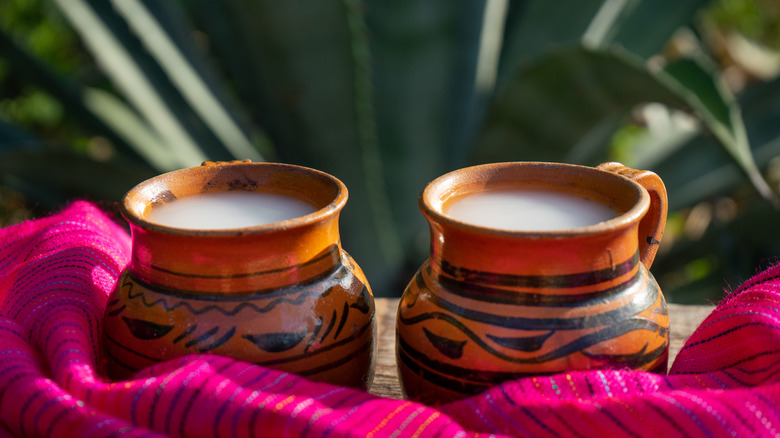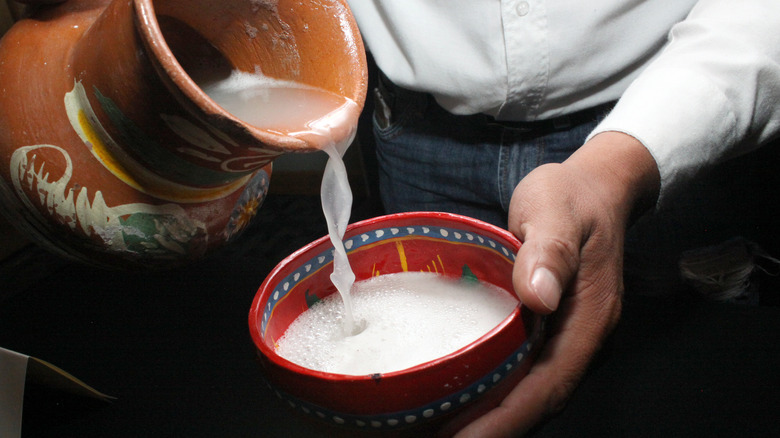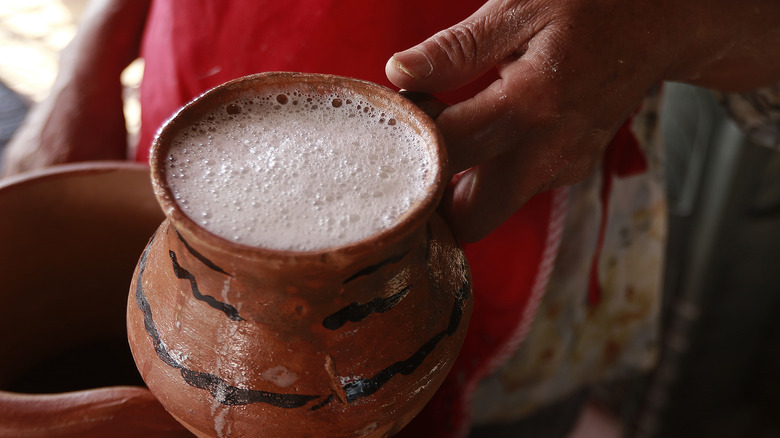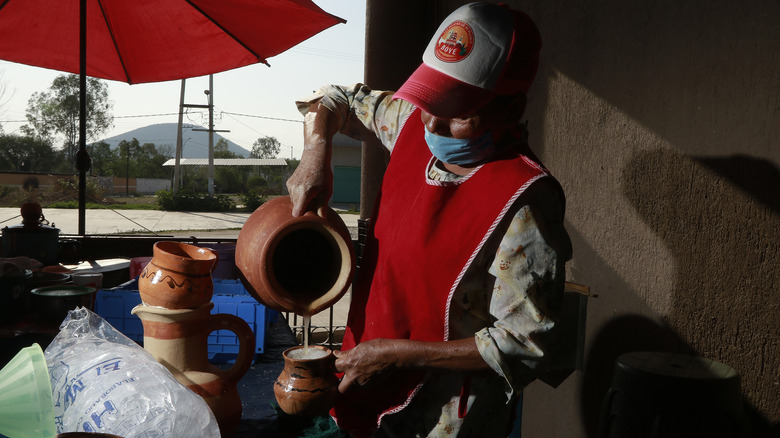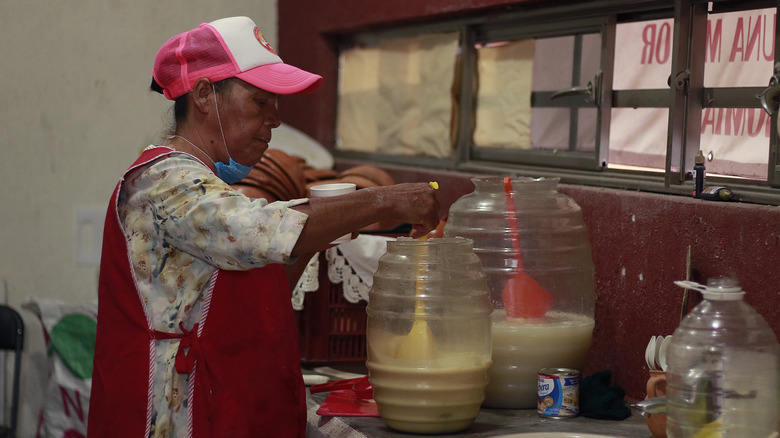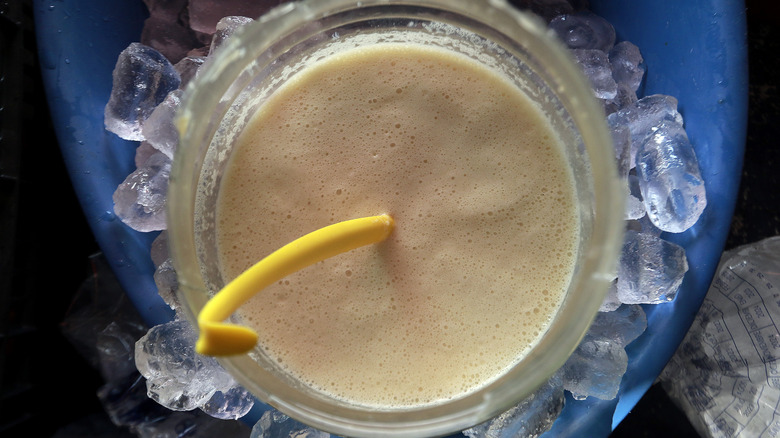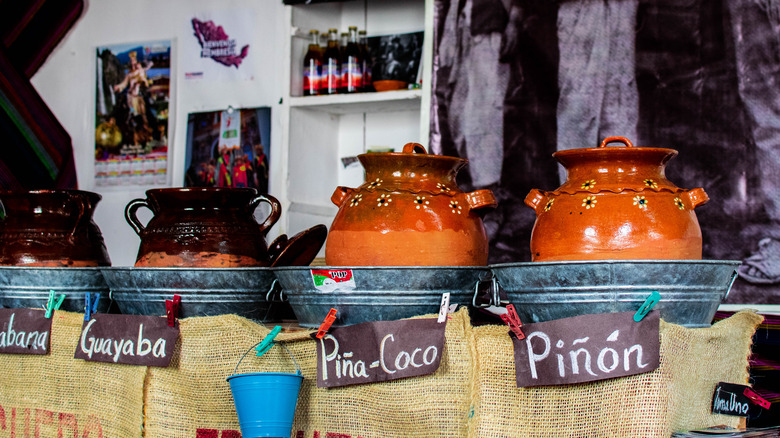Pulque: The Ancient Mexican Agave Drink You Should Know About
Pulque is uniquely Mexican, with a long history to prove it: some researchers have found traces of pulque in vessels dating back to 200 A.D. Once considered the beverage of Aztec gods, this milky, acidic drink has quite an impressive resume as an intoxicant, sedative, medicine, and celebratory libation (via Agave Cocina). A derivative of agave, pulque is nothing like its distant relatives mezcal or tequila. Instead of being taken from the heart of the plant, it is fermented from sap called aguamiel (per Thrillist).
Traditionally stored in large ceramic vats, not much has changed about the processing or presentation of pulque, and you can still find the drink being served in central Mexico — many note that it is even seeing a cultural resurgence. If you're looking for a taste of history or simply want to drink something that unites you with an ancient Aztec, a sip of this frothy drink might be the ticket.
What is pulque?
Simply put, pulque is a fermented beverage with a low alcohol content. It was a drink once reserved for a select few individuals: sacred priests, revered gods, and pregnant women (in no particular order). Once the Aztec civilization collapsed, however, it fell into the hands of ordinary, everyday people and could be found easily throughout Mexico's central regions (via Serious Eats). Until prohibition regulated the distribution and sale of pulque, this white, oozy drink was regarded as an effective medicine, a meaningful part of the culture, and a significant source of income for farmers and ranchers with access to agave plants.
Railroads accelerated its distribution. As vats of the beverage arrived in areas around Mexico City, the bitter taste remained a popular choice for thirsty bar-goers until calculated social campaigns pushed pulque out of the spotlight and replaced it with the more easily kept and transported beer.
How is pulque made?
The process of making pulque hasn't changed much over the years; it is still an artisanal craft mostly done in homes or by smaller manufacturers. Production remains concentrated around Mexico's central region, where agave plants are abundant.
The main ingredient in pulque is sap from a mature agave plant — and agave plants can take over a decade to mature (per Thought Co.). When they are finally ready for harvest, the liquid isn't collected in one go but is instead collected daily by a tlachiquero, a knowledgeable cultivator who skillfully extracts the aguamiel and sets it into barrels and vats to ferment. Agaves produce this sap for three to six months before the plant dies, which can result in the production of up to 1000 liters of aguamiel, according to Frontiers in Microbiology. Fermentation doesn't require any stirring, and a batch can be ready for consumption in as little as three hours. Because pulque's fermentation process is so complex, researchers have attempted to study the chemical processes.
What does pulque taste like?
"While it's known as the Aztec drink of the gods, to the uninitiated, pulque seems anything but divine," Brad Cohen wrote in his BBC Travel piece. "Before I ever tried it, I listened to dozens of people struggle to describe its texture." He reports that, in addition to warnings he received before sampling the beverage for the first time, some of the descriptions of the texture were... a bit foul.
Serious Eats advises that the fresher the pulque, the cleaner, smoother, and more refreshing the taste. As the drink ages and continues to ferment, it becomes thicker, stickier, and can even become stringy, much like those little brown strings found in kombucha. We can't mince words here: pulque in its purest form can be acidic, sour, and a bit difficult to put back. Thankfully, fermented pulque can be blended with fruit and spices to make the taste a bit more palatable.
Where to buy pulque
Within a few days, pulque can turn rancid, so it's difficult to find outside of Mexico. Pulquerías serve up the best pulque, according to Serious Eats; many of these establishments are decorated with murals of historical figures, others have walls plastered with photos and memories of years gone by, and most serve up small plates and snacks to hungry patrons.
At the beginning of the 20th century, you could find pulque easily throughout Mexico City; over 1,000 vendors were dishing out cups. But once beer took over, the number of pulquerías dropped to fewer than 100 (via Atlas Obscura). These pulquerías are like taverns and bars that encapsulate the pulque's stronghold in Mexican society. After haciendas pulquerías, large farms focused on pulque production, and the pulquerías became a kind of cultural phenomenon. Their presence remained strong until authorities put caps on hours of operation and activities conducted therein. Pulquerías buckled under social pressure until some entrepreneurial Mexicans decided to reclaim this element of society, presenting a more socially-positive experience, promoting cultural tourism, and attempting to educate consumers on pulque's colorful history.
Nutritional information about pulque
Because of its complex fermentation process, pulque is considered a "viscous and slightly acidic alcoholic beverage," according to Frontiers; its consumption has been said to yield an assortment of research-backed health benefits: from successfully treating prisoners with scurvy to providing a variety of minerals, vitamins, and nutrients — thiamin, riboflavin, niacin, iron, folate, biotin, B and C vitamins, to name a few.
Packed with immune-supporting probiotics and proteins, pulque has been championed for its positive effects on the digestive system. It has even been touted for its ability to increase milk production in lactating women and was believed to increase virility in men (per El Refugio). Whether or not those claims are true is up for debate, but like other fermented foods, pulque has the potential to impact gut and intestinal health. El Universal further reports that pulque can help prevent gastrointestinal disease, calm gastrointestinal distress, and lower cholesterol.
Other varieties of pulque
Trendy neo-pulquerías in Mexico's urban areas now cater to hipsters and nostalgia-seekers with updated pulque recipes, serving up much more palatable versions of the fermented drink before hosting dance parties (via MIC). As BBC's Brad Cohen reports, cured pulque, known as curado, can be mixed with oatmeal, guava, or tomato, for example, but with anywhere from 2-8% alcohol by volume, the effects of the beverage can creep up on you.
According to Inside Hook, the concoctions can be delicious when chilled. "You can sit there and drink pulque for hours, and you just don't get drunk," Donnie Masterson told BBC. "Then you get up to leave and realize your legs don't really work right. Your mind is completely clear, but your body doesn't work." Consider this your warning: if you decide to take the pulque plunge, we recommend steeling yourself and proceeding with a bit of caution.
